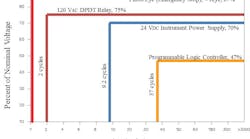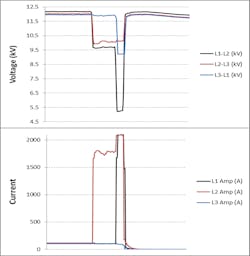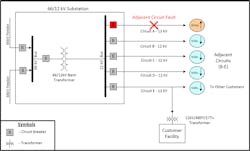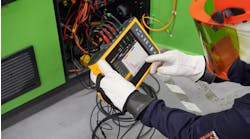It was a typical night shift at ABC Manufacturing. One hundred employees worked meticulously to assemble aerospace hardware for a large spacecraft project. The company was running on time for delivery but could not get behind in production. On this unassuming night, in the blink of an eye, the plant shut down and production ground to a halt. The plant electricians scurried around the production line to assess the situation. They found seven variable-frequency drives (VFDs) with an undervoltage trip fault code and two of the main production line programmable logic controllers (PLCs) with corrupted programming. Production stopped long enough to cost ABC Manufacturing $450K in losses.
When the employees on the manufacturing lines were surveyed about the incident, they recounted that the area lighting flickered without shutting off. At the same time, the production line halted. The electricians reported that no circuit breakers tripped, and power was never lost. The electric utility was contacted and reported no outage on the circuit that feeds their facility. What happened to cost ABC Manufacturing $450K?
Seeking an answer
First, we must define power quality. The Institute of Electrical and Electronics Engineers (IEEE) defines power quality in IEEE 1100-2005 ― Recommended Practice for Powering and Grounding Electronic Equipment, as “the concept of powering and grounding electronic equipment in a manner that is suitable to the operation of that equipment and compatible with the premise wiring system and other connected equipment” (1100-2.2.63). To clarify further, if the facility is wired to meet only the minimum requirements of NFPA 70, National Electrical Code (NEC), the premises is considered safe to protect personnel and property (Sec. 90.1).
Sensitive electronic equipment may or may not operate as intended with this basic wiring. IEEE 1100-2005 clarifies that most sensitive electronic equipment requires additional grounding and power conditioning to operate as intended. In the electrical industry, power quality is seldom considered when designing and installing sensitive electronic equipment. Sensitive electronic equipment can be any equipment that utilizes power electronics for its operation (e.g., VFDs, PLCs, industrial process controls, robotic equipment, etc.).
Identifying the culprit
In the fictitious example of ABC Manufacturing, VFDs and PLCs were cited as the weak link in the manufacturing process. However, there was no power outage or tripped circuit breakers. So, what happened that could have caused such great losses? The power quality anomaly that occurred in this story is the most common cause of financial loss for companies. The anomaly is called a voltage sag.
Voltage sags are defined by IEEE 1159-2019 ― Recommended Practice for Monitoring Electric Power Quality, as “a decrease in rms voltage to between 0.1 per unit (pu) and 0.9 pu for durations from 0.5 cycles to 1 min.” (1159-2019-4.4.2.2). An example of this definition can be observed with the blink of a human eye, which takes 300 msec to 400 msec to blink while the duration of a voltage sag is 8 msec to 500 msec. Voltage sags are very fast reductions in voltage that affect sensitive electronic equipment.
However, all sensitive equipment is not made the same, and the threshold for shutdown can vary widely. For example, VFDs will shut down during a voltage sag to protect the drive electronics and motor from damage. The DC bus in a VFD is closely monitored by the control system, and when a voltage reduction is detected, the output to the motor is stopped. This typically results in an undervoltage fault code. The PLC, on the other hand, can become corrupted or simply shut down by a voltage sag. PLCs are essentially industrial computers that must be supplied with voltage within an acceptable range.
Voltage sags can be caused by two common power system events: system faults and the switching of high current loads. System faults will be the focus of the remainder of this article. To understand the cause of voltage sags, a reminder of electrical theory is warranted. The inverse relationship between voltage and current is the primary motive for a voltage sag. Simply put, as the current in an electrical system rises, the voltage will decrease proportionally to the magnitude of the current (Fig. 1).
System faults can occur at a facility and manifest as a tripped circuit breaker. Most of these events are quickly attributed to an internal problem and rectified accordingly. However, most unexplained voltage sags can be ascribed to line-side voltage sags on the electrical distribution and transmission systems operated by local municipalities and electrical utilities. Distribution and transmission system faults can be caused by vehicles hitting poles, metallic balloons contacting conductors or equipment, animal contact with the power lines, vegetation contact with power lines, weather, and failed equipment — to name a few. When phase-to-phase or phase-to-ground system faults occur, the current rises at the same time the voltage is being drawn toward 0V. This will result in a circuit breaker opening at the substation and may cause an outage. Customers served by the affected circuit will lose power, resulting in an explainable shutdown of equipment. Companies such as the one used in the example did not lose power but still had equipment shut down. Voltage sags that do not result in an outage typically are credited to a system fault on an adjacent circuit in the same substation. Figure 2 provides this illustration. As current rises on Circuit A from the system fault, the voltage on the substation bus is driven toward 0V. All the customers on Circuits B-E experienced a voltage sag.
The magnitude and duration of the voltage sag are helpful to know when assessing the sensitivity of the equipment. However, without power quality monitoring, this may not be known. By contacting the local municipality or electric utility and providing the date and time of the shutdown, the circuit can be identified as the cause. A rough assumption can be made by knowing the voltage level of the system fault. Typically (and this varies by electric utility and relay type), transmission relays will open a circuit breaker within 6 cycles, while a distribution relay will open a circuit breaker in 30 to 120 cycles. For example, if the system fault was on the distribution system, then the sensitive electronic equipment will be affected by a duration of only 30 cycles.
Although magnitude may be missing, knowing the average operational thresholds of various electrical and electronic equipment will be enough to select the best mitigation technology to help reduce the occurrences of a shutdown. Examples are provided in Fig. 3.
Each type of device has a specific range of sensitivity. An AC “ice cube” DPDT relay is more sensitive than its equivalent DC relay. This is due to the characteristics of the DC power supply that has a built-in ride-through by its design, which allows the DC relay to hold in longer in magnitude and duration as compared to the AC relay. PLCs are typically sensitive to 47% of nominal voltage (magnitude) and a duration of 37 cycles.
Finding a solution
Identifying the most sensitive components in the manufacturing process, control, and/or communication systems is the first step toward a low-cost solution to voltage sag sensitivity. In the ABC Manufacturing example, it would be prudent to evaluate VFD settings to provide built-in ride-through and mitigation technology to allow the PLC to ride through the voltage sags. Most VFD manufacturers have built-in flying and auto-restart functions that allow the drive to ignore the fault and continue operation. Extreme caution must be taken to evaluate the process for safety when implementing these settings. Some processes cannot utilize flying and auto-restart, requiring alternate mitigation options. The PLC power supply could be mitigated by installing a ferroresonant transformer to provide voltage support during a voltage sag.
There is no broad-brushed approach to mitigation technology selection. It will vary by installation location, magnitude and duration requirements, and cost [return on investment (ROI)]. While voltage sag causes can be outside the control of the local municipality or electric utility, customers must use best engineering practices to harden their electrical systems and mitigate the sensitive equipment. In almost all cases, the cost of mitigation equipment will provide a short duration ROI when compared to the cost of facility shutdowns.
Bryan Glenn is a certified power quality (CPQ) professional who manages the Power Quality Department for Southern California Edison. In addition to being a member of several IEEE Power & Energy Society working groups, he’s also an Adjunct Professor of Industrial Electricity for Chaffey College, holds a California Electrical Contractors License (C-10), and is a former commercial and industrial inside wireman. He can be reached at [email protected].






